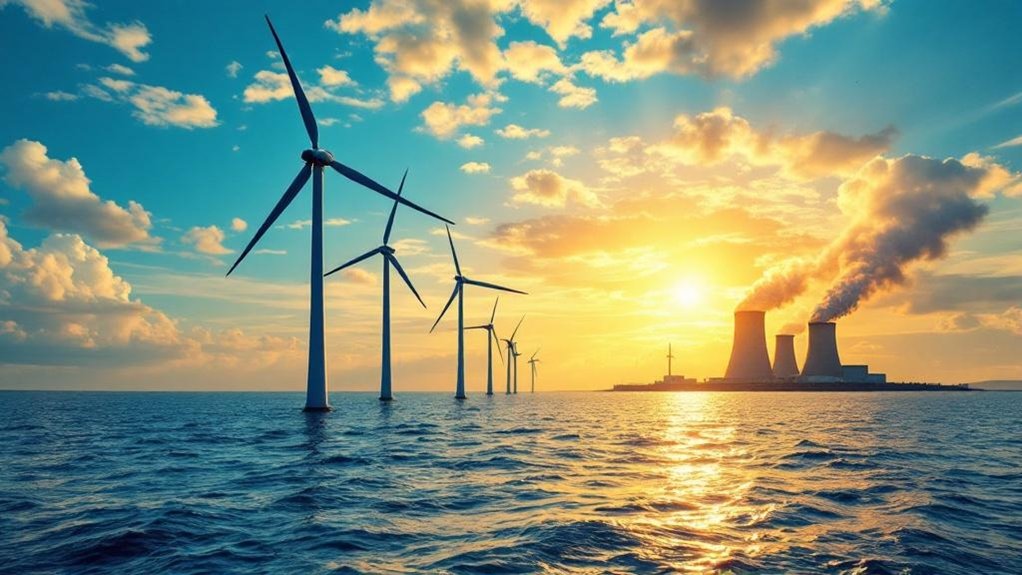
Offshore Wind Energy Vs Traditional Power Sources
Offshore wind energy presents a compelling alternative to traditional power sources, particularly in the context of environmental sustainability. Its ability to generate cleaner electricity by harnessing ocean winds contrasts sharply with the detrimental effects of coal and natural gas. However, significant challenges persist, particularly concerning costs and integration. As the world grapples with climate change, understanding the implications of this energy shift becomes increasingly critical. What lies ahead in the battle for a sustainable energy future?
Understanding Offshore Wind Energy
Although renewable energy sources have gained significant attention in recent years, offshore wind energy stands out due to its vast potential and efficiency. This form of energy harnesses the power of wind currents over oceans and large bodies of water, where wind speeds are generally higher and more consistent than on land. Offshore wind turbines are typically larger and more advanced, designed to withstand harsh marine environments. The strategic placement of wind farms can minimize visual impact and land use conflicts, making them an attractive alternative to traditional energy sources like coal and natural gas. As technology continues to advance, the capacity and reliability of offshore wind energy are expected to improve, positioning it as a critical component of the global shift to sustainable energy. Moreover, renewable energy sources produce little to no greenhouse gas emissions, reinforcing the environmental benefits of offshore wind energy.
Advantages of Offshore Wind Farms
Offshore wind farms offer numerous advantages that position them as a leading choice for renewable energy generation. The offshore environment provides consistently stronger and more reliable winds compared to onshore locations, leading to increased energy output. Additionally, these farms operate at a larger scale, enabling the generation of substantial amounts of electricity to meet growing energy demands. Offshore wind farms also contribute to reduced greenhouse gas emissions, thereby mitigating climate change effects. Moreover, they have minimal visual and noise impacts on coastal communities, making them more publicly acceptable. The potential for technological advancements in turbine design and energy storage enhances their efficiency and reliability. Overall, offshore wind farms represent a sustainable and effective solution for shifting to cleaner energy sources. Furthermore, they align with the principles of sustainable living, which emphasize reducing reliance on fossil fuels and promoting renewable energy alternatives.
Challenges Facing Offshore Wind Energy
The development of offshore wind energy faces several significant challenges that must be addressed to realize its full potential. One major issue is the high cost associated with installation and maintenance, particularly in deep-water locations where infrastructure is limited. Additionally, adverse weather conditions can disrupt operations, impacting energy production and reliability. Environmental concerns also arise, as the construction and presence of wind farms may affect marine ecosystems and local wildlife. Moreover, regulatory hurdles can delay project approvals, complicating the permitting process. Finally, the integration of offshore wind energy into existing power grids presents technical challenges that require innovative solutions to guarantee stability and efficiency. Addressing these challenges is vital for advancing offshore wind as a viable energy source, especially as hybrid work models are becoming increasingly popular, necessitating reliable energy sources for diverse work environments.
Traditional Power Sources: An Overview
As energy demands continue to rise, traditional power sources remain a cornerstone of global electricity generation. These sources primarily include fossil fuels such as coal, oil, and natural gas, alongside nuclear energy. Fossil fuels, known for their abundance and established infrastructure, have historically powered economies and are responsible for a significant portion of electricity production worldwide. Nuclear energy, while less prevalent, provides a stable and large-scale energy output with minimal fuel costs once operational. However, the reliance on these sources raises concerns regarding energy security and price volatility. Despite advancements in renewable energy technologies, traditional power sources continue to play an essential role, meeting immediate energy needs while the shift to more sustainable alternatives develops. Furthermore, the concentration of power among fossil fuel industries can lead to challenges in transitioning to renewable energy solutions.
Environmental Impact of Energy Sources
The environmental impact of energy sources is a critical issue, particularly when comparing offshore wind energy to traditional power methods. Carbon emissions, wildlife disruption, and resource depletion present significant challenges that warrant thorough examination. Understanding these factors is essential for evaluating the long-term sustainability of various energy options. Additionally, mindfulness can play a role in promoting awareness of the environmental consequences tied to our energy choices.
Carbon Emissions Comparison
While various energy sources contribute to carbon emissions, offshore wind energy stands out as a remarkable cleaner alternative compared to traditional power sources such as coal and natural gas. Offshore wind farms generate electricity without producing direct carbon emissions, greatly reducing the overall carbon footprint associated with energy production. In contrast, coal-fired plants emit substantial amounts of carbon dioxide and other greenhouse gases, contributing to climate change. Natural gas, although cleaner than coal, still releases considerable carbon emissions during combustion. The shift to offshore wind energy not only mitigates carbon emissions but also promotes a sustainable energy future. By harnessing wind power, societies can decrease their reliance on fossil fuels and move towards achieving climate goals, emphasizing the importance of cleaner energy technologies.
Wildlife Disruption Assessment
How does the installation of offshore wind farms affect local wildlife? The presence of offshore wind farms can disrupt marine ecosystems considerably. The construction phase often leads to noise pollution, which can interfere with the communication and navigation of marine species, particularly mammals and fish. Additionally, the physical structures may alter habitats, affecting the distribution and behavior of local wildlife. Birds are particularly at risk, as they may collide with turbine blades during migration. However, studies indicate that the long-term benefits of reduced carbon emissions may ultimately contribute to healthier ecosystems. It remains essential to conduct thorough wildlife disruption assessments prior to installation, ensuring that potential impacts are identified and mitigated effectively, therefore balancing renewable energy development with ecological preservation.
Resource Depletion Effects
Resource depletion is a significant concern when evaluating the environmental impact of various energy sources. Traditional power sources, such as fossil fuels, heavily rely on finite resources, leading to severe depletion of natural reserves. The extraction processes, including mining and drilling, often result in habitat destruction and pollution. In contrast, offshore wind energy harnesses natural wind currents, requiring no fuel extraction and minimizing resource depletion. However, the production of wind turbines involves some resource use, including metals and rare earth elements, which can also contribute to environmental degradation if not managed sustainably. Shifting to renewable energy sources like offshore wind can alleviate resource depletion effects, promoting a more sustainable energy future while safeguarding the planet’s ecological balance.
The Future of Energy: Transitioning to Renewables
As the global focus shifts towards sustainability, the change to renewable energy sources presents numerous benefits, including reduced emissions and enhanced energy security. Technological advancements are paving the way for more efficient and cost-effective renewable solutions, making them increasingly viable alternatives to traditional power sources. Additionally, evolving policy frameworks and investment trends are essential in supporting this change and fostering a greener future.
Renewable Energy Benefits
The change to renewable energy represents a crucial shift in addressing global energy needs and environmental concerns. Renewable energy sources, such as wind, solar, and hydroelectric power, offer numerous advantages over traditional fossil fuels. They significantly reduce greenhouse gas emissions, contributing to a cleaner atmosphere and mitigating climate change. Furthermore, renewables enhance energy security by diversifying energy supplies and decreasing dependence on imported fuels. The growth of the renewable energy sector also fosters job creation and economic development, particularly in manufacturing and installation. Additionally, as technology evolves, the cost of renewable energy continues to decline, making it increasingly accessible to consumers. Collectively, these benefits position renewable energy as an essential component of a sustainable and resilient energy future.
Technological Advancements Ahead
While the change to renewable energy sources is already underway, continued technological advancements promise to accelerate this shift even further. Innovations in offshore wind energy, such as larger turbines and improved materials, enhance efficiency and reduce costs. Enhanced predictive analytics and artificial intelligence optimize energy production by improving site selection and maintenance schedules. Additionally, advancements in energy storage technologies, including batteries and hydrogen solutions, address the intermittency issues associated with renewable energy sources. Floating wind farms, capable of operating in deeper waters, expand the potential for offshore installations. These developments not only increase the viability of offshore wind energy but also contribute to a more sustainable energy future, positioning renewables as a dominant force in the global energy landscape.
Policy and Investment Trends
With the rapid advancements in offshore wind energy technology, a corresponding change in policy and investment trends is becoming increasingly evident. Governments worldwide are recognizing the need to shift from traditional power sources to renewable energy, leading to favorable regulatory frameworks and financial incentives. Countries such as the United States, Germany, and the United Kingdom are greatly increasing their investments in offshore wind projects. Public and private sectors are collaborating to establish ambitious targets for renewable energy capacity, driven by climate commitments. Additionally, venture capital is increasingly directed toward innovative offshore wind solutions, signaling a robust market confidence. This growing trend reflects a broader commitment to sustainability and energy independence, positioning offshore wind as a central component of future energy strategies.
Frequently Asked Questions
How Do Offshore Wind Farms Affect Local Fishing Industries?
Offshore wind farms can impact local fishing industries by altering fish habitats, potentially leading to reduced catch in some areas. However, they may also create new ecosystems, which can enhance fishing opportunities in different regions.
What Is the Lifespan of an Offshore Wind Turbine?
The lifespan of an offshore wind turbine typically ranges from 20 to 25 years, depending on factors such as maintenance, environmental conditions, and technological advancements. Regular assessments are essential to guarantee peak performance throughout its operational life.
Can Offshore Wind Energy Be Stored for Later Use?
Offshore wind energy can be stored for later use through various technologies, such as batteries and pumped hydro storage. These systems help manage supply and demand, ensuring energy availability even when wind generation is low.
How Is the Maintenance of Offshore Wind Farms Conducted?
Maintenance of offshore wind farms is conducted through regular inspections, scheduled repairs, and specialized vessels. Technicians assess turbine performance, conduct mechanical repairs, and guarantee safety protocols, often utilizing advanced technology for efficient monitoring and maintenance operations.
What Are the Costs Associated With Decommissioning Wind Turbines?
Decommissioning wind turbines involves costs related to dismantling, transporting materials, and site restoration. Additional expenses may arise from regulatory compliance and environmental assessments, making the overall financial commitment significant for project developers and stakeholders.
Conclusion
In summary, offshore wind energy presents a viable and sustainable alternative to traditional power sources, offering significant environmental benefits and aiding in the reduction of greenhouse gas emissions. While challenges such as high installation costs and technical integration must be addressed, the potential for economic growth and advancements in technology within the offshore wind sector are promising. Shifting to renewable energy sources like offshore wind is essential for enhancing energy independence and combating climate change in the future.



